The art reception for the Sequoia Art Show was well attended. It appeared that everyone had a good time. I did. Thank you for coming!
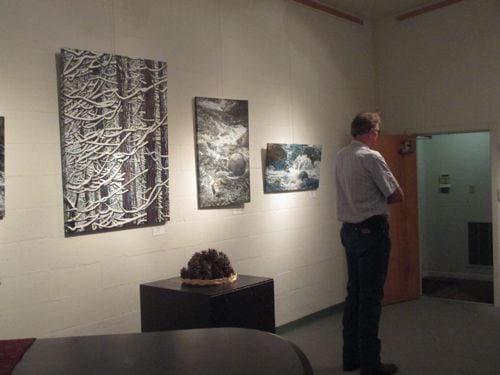

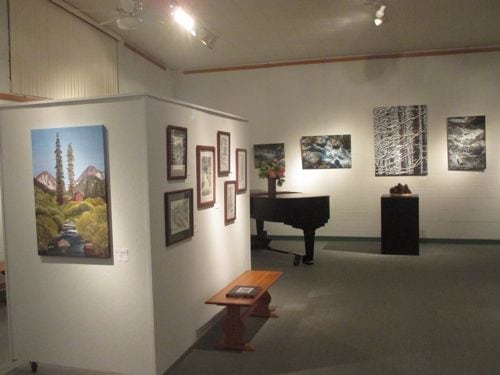
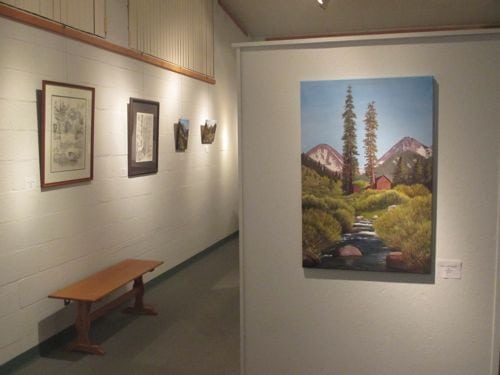

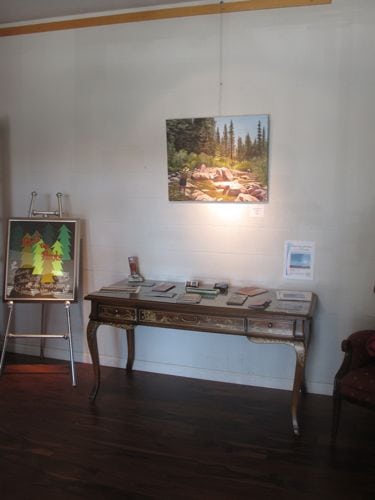
P.S. These 2 sold:

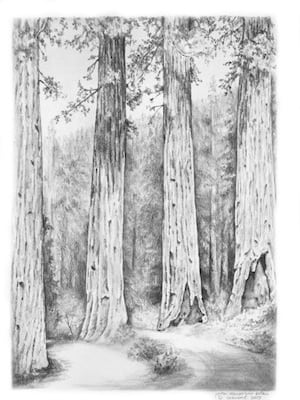
The art reception for the Sequoia Art Show was well attended. It appeared that everyone had a good time. I did. Thank you for coming!






P.S. These 2 sold:


Sequoia trees and navel oranges are specialties of Central California, right here in Tulare County where I live and work as an artist (and now as an editor too).
So, I paint Sequoia trees and navel oranges. Often.
When these are dry, I’ll scan them and put them on my website for sale. Maybe I’ll put them on the blog too.
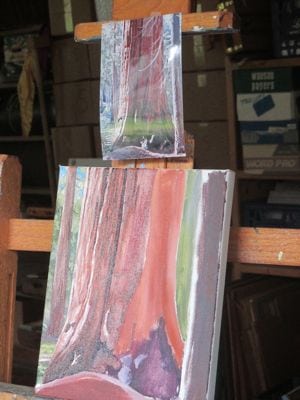

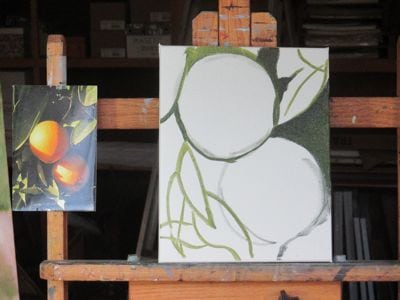

These are some of the paintings on the easel and drying on the walls around the painting studio/workshop. I did them for the Studio Tour. After spending an entire year just drawing the cabins of Wilsonia, it was time to paint again.
Always gotta have citrus paintings – what else would you expect from a California artist? These are each 6×6, a very popular size in kitchen art.
These pomegranates are 4×4″. Like the shoes? Ugly as sin, but oh so very comfortable. I thought about cropping them out of this photo, but got lazy. This palette served as a convenient tray for transporting these little wet paintings. The weird circle behind the painting on the upper right is an old color wheel. The palette is a gift from someone whose mother used to paint. Most of my supplies are gifts from people whose mothers and mothers-in-law used to paint.
The yarn in the photo is lavender and blue. I have been on a roll for a couple of years just loving the combination of teal and brown, so that’s what I am making the yarn in the painting. The photo is showing me the twist pattern, the size of the strands, and the way the light and shadow fall. This is called “using a photo for reference”, because out there in ArtWorld, working from photos is met with a lot of contempt.
The Kaweah River is on my list of Oil Painting Subjects To Always Have On Hand. I’ve painted this scene before. This time it is 10×10″ square, and the colors are a bit juiced up, although it is hard to tell when looking at a photo of a photo.
Ditto the Kaweah Post Office. This is the first time I’ve included the monument marker. Painting it on a square canvas got my eye confused, and the proportions were whacky at this stage. I fixed it later.
Careful! The paint is wet on these! The piece of paper is how I keep track of where I am on which painting. I could just look around the room and see, but a list makes me feel more productive and efficient. Never mind that it might be a waste of time to make the list and to keep it current. I’m 53 and I can do what I want. Wait a minute – am I 54? I can’t remember!
The top and bottom paintings sold at the Studio Tour. Time to paint another Mineral King!
The Studio Tour was a success in many ways. I found 2 new drawing students, saw old friends and students, met new friends, made contact with folks that I’d only talked to on the phone before, and lots of other important things.
And, these are some of the paintings that sold.
Meadow Fence, 10×10, oil painting on wrapped canvas, a Sequoia National Park oil painting
Vandever-Mineral King, 10×10, oil on wrapped canvas, a Mineral King oil painting
Peach on Tree, 6×6, oil on wrapped canvas
North Fork of the Kaweah, 11×14, oil on wrapped canvas, a Three Rivers oil painting
Sequoias, AKA “big trees”, are something I really love to paint (and draw). On my doors, on canvas, (or on paper.)
I liked the painting on my door so much that I decided to do the same scene on canvas.
First step – draw it vaguely with a paintbrush.
Second step, get the base coat on.
Third step, begin the background and add layers to everything else.
Fourth step, photograph it inside the painting workshop with the sequoia doors open.
Fifth step, photograph it with the other two doors of redwoods.
Seventh step, photograph it while it is drying.
(Sixth step was to finish painting it. Did you think I messed up on counting? Wouldn’t have been the first time!)
Doesn’t that sound like a terse newspaper heading?
The Sequoia tree mural of a section of the Parker Group on one of my ridgey garage doors is now completed. Maybe. I signed it, but when I live with a piece of art, little corrections ask to be made. So, is it finished?
I spent 18 hours painting this in about 7 different sessions, the longest of which was 4 hours. Of course, I might keep fiddling with it, so there may be more.
If a customer wanted this exact mural on this exact surface and this exact size and I didn’t have to drive more than 1 mile to paint it (definitely rounding up because I drove no where to paint this), I’d charge $700.
I knew you were dying to ask, but there is this weirdness about art prices. . . the old “If you have to ask, you probably can’t afford it.”
No worries. The truth is what is spoken and written here and no one has any reason for embarrassment when he doesn’t know something. This California artist who paints Sequoia trees just wants to help you.
For awhile, I’ve been advising you to view my Sequoia mural from the back of a fast horse, preferably at a distance. I’m beginning to think that it might be okay to slow your horse down now, but distance is still an advantage for best viewing.
Getting better with each session. This is the result of 15 hours up and down a ladder. You’d think I’d be quite fit by now. Have another think. . .
The ridges aren’t quite as visible in this photo.
I have a few decisions to make about this project. . . add a human? Will she be the right height? Will the ridges and my inexperience painting humans make her look like a freak? What shall I do in the hard to figure out spaces behind the big trees? How will I put light on the ground behind the trees without it looking as if there is snow? How will I be sure that the traces of snow at the bases of the trees do look like snow? Does there even need to be snow?
That’s sort of overwhelming. I think I’ll just turn away from the mural and see the view behind me.
The Sequoia mural on a ridgey garage door continues. Here is what my view looks like while I am painting:
The horizontal blue line is so I can tell where I am. It is the center from top to bottom.
I don’t know exactly what I am doing when I am this close to the wall. That is why I am continually climbing up and down the ladder.
This guy doesn’t know what I am doing either:
For some reason, it embarrasses me to admit this. So, I put it as the title of this post – practice saying it, feel it, face it. (Say it loud, say it proud?) I am a California Artist and I love Tulare County! (Is it warm in here or is it just me?)
Oranges #121, 8×10″, oil on wrapped canvas, $90, available here
My cousins visited from Northern California. She is from the Chicago area and he grew up near Buffalo. (They are married so I consider him to be my cousin too.)
We spent part of a day in Sequoia. This is where they met while working for The Park’s concessionaire. (Here in Three Rivers we refer to Sequoia National Park as “The Park”.)
Sunny Sequoias XVIII, 8×8″, oil on wrapped canvas, $75, available here
Girl Cousin has inherited a portion of an orange grove where I spend the first 11 years of my life. (Don’t worry – we lived in a house, not under a tree.) So, we visited the grove. City folks say “ranch” and Citrus folks say “orchard” or “grove”.
Oranges #121, 8×10″, oil on wrapped canvas, $90, available here
Several thoughts:
P.S. Three Rivers might still be the best place to live in Tulare County, but my second choice is in an orange grove at the edge of the foothills.
*I have to point these things out so you all won’t move here.
Two of my neighbors have requested that I paint slowly. They want to enjoy the process of seeing a mural develop.
With this mural of Sequoia trees on a ridgey door, I don’t have a choice. In my head the thing should be going quickly, but reality is much different.
I climb down the ladder and squint and study. It needs more light here, more detail there. I climb the ladder and then can’t figure out where the light and detail were supposed to go. I climb back down and look again. Hmmm, three ridges down, more light. More detail on the top ridge and on the 4th ridge, crossing down onto the 6th ridge. Climb back up the ladder. Add the light, and forget where the detail was needed. Climb back down, oh yeah, that’s right, climb back up, and now my brushes are all dried out. Climb back down and get them cleaned up a bit in water. Climb back up and wonder what I was supposed to do. Realize the color I need is dried on the palette, Climb down the ladder and pour more on. Squint up at the mural and see another area needs attention. Move the ladder, climb up and try to GET SOMETHING PAINTED!!
Please excuse me for shouting. This should not be so hard.
Okay Bob and Katie, I’m a slow painter for sure. And Katie, thank you for the blog post idea!